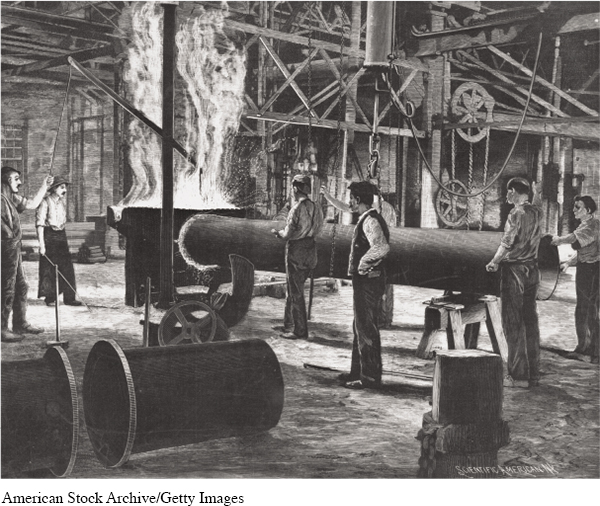Innovation and Inventions
As important as railroads were, they were not the only engine of industrialization. American technological innovation created new industries, while expanding the efficiency and productivity of old ones. In 1866 a transatlantic telegraph cable connected the United States and Europe, allowing businessmen on both sides of the ocean to pursue profitable commercial ventures. New inventions also allowed business offices to run more smoothly: Typewriters were invented in 1868, carbon paper in 1872, adding machines in 1891, and mimeograph machines in 1892. As businesses grew, they needed more space for their operations. The construction of towering skyscrapers in the 1880s in cities such as Chicago and New York was made possible by two innovations: structural steel, which had the strength to support tall buildings, and elevators.
Alexander Graham Bell’s telephone revolutionized communications. By 1880 fifty-five cities offered local service and catered to a total of 50,000 subscribers, most of them business customers. In 1885, Bell established the American Telephone and Telegraph Company (AT&T), and long-distance service connected New York, Boston, and Chicago. By 1900 around 1.5 million telephones were in operation.
Perhaps the greatest technological innovations that advanced industrial development in the late nineteenth century came in steel manufacturing. In 1859 Henry Bessemer, a British inventor, designed a furnace that burned the impurities out of melted iron and converted it into steel. The open-hearth process, devised by another Englishman, William Siemens, further improved the quality of steel by removing additional impurities from the iron. Railroads replaced iron rails with steel because it was lighter, stronger, and more durable than iron. Steel became the major building block of industry, furnishing girders and cables to construct manufacturing plants and office structures. As production became cheaper and more efficient, steel output soared from 13,000 tons in 1860 to 28 million tons in the first decade of the twentieth century.
Factory machinery needed constant lubrication, and the growing petroleum industry made this possible. A new drilling technique devised in 1859 tapped into pools of petroleum located deep below the earth’s surface. In the post–Civil War era, new distilling techniques transformed petroleum into lubricating oil for factory machinery. This process of “cracking” crude oil also generated lucrative by-products for the home, such as kerosene and paraffin for heating and lighting and salve to soothe cuts and burns. After 1900, the development of the gasoline-powered, internal combustion engine for automobiles opened up an even richer market for the oil industry.
Railroads also benefited from innovations in technology. Improvements included air brakes and automatic coupling devices to attach train cars to each other. Elijah McCoy, a trained engineer and the son of former slaves, was forced because of racial discrimination to work at menial railroad jobs shoveling coal and lubricating train parts every few miles to keep the gears from overheating. This experience encouraged him to invent and patent an automatic lubricating device to improve efficiency.
Early innovations resulted from the genius of individual inventors, but by the late nineteenth century technological progress was increasingly an organized, collaborative effort. Thomas Alva Edison and his team served as the model. In 1876 Edison set up a research laboratory in Menlo Park, New Jersey. Housed in a two-story, white frame building, Edison’s “invention factory” was staffed by a team of inventors and craftsmen. In 1887 Edison opened another laboratory, ten times bigger than the one at Menlo Park, in nearby Orange, New Jersey. These facilities pioneered the research laboratories that would become a standard feature of American industrial development in the twentieth century.

Out of Edison’s laboratories flowed inventions that revolutionized American business and culture. The phonograph and motion pictures changed the way people spent their leisure time. The electric light bulb illuminated people’s homes and made them safer by eliminating the need for candles and gas lamps, which were fire hazards. It also brightened city streets, making them available for outdoor evening activities, and lit up factories so that they could operate all night long.
Like his contemporaries who were building America’s huge industrial empires, Edison cashed in on his workers’ inventions. He joined forces with the Wall Street banker J. P. Morgan to finance the Edison Electric Illuminating Company, which in 1882 provided lighting to customers in New York City. Goods produced by electric equipment jumped in value from $1.9 million in 1879 to $21.8 million in 1890. In 1892, Morgan helped Edison merge his companies with several competitors and reorganized them as the General Electric Corporation, which became the industry leader.
Exploring American HistoriesPrinted Page 520
Exploring American Histories Value EditionPrinted Page 384
Chapter Timeline